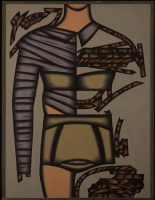Written by: Sylvie Coffey – Social Media Intern
Christina Ramberg (1946-1995) was an American painter and best known for her works of art that call attention to the objectification of women’s figures. Her paintings display fragmented bodies highlighting the various undergarments used in the transformation of an individual’s body. Ramberg did not include faces within her art pieces and frequently left out the head as well, or otherwise covered by hair or highlighting the torso from the back. Commenting on her inspiration of this style, which came from watching her mother get dressed in the 1950s, Ramberg stated “I think the paintings have a lot to do with this, with watching and realizing that a lot of these undergarments totally transform a woman’s body. Watching my mother getting dressed I used to think that this is what men want women to look like, she’s transforming herself into the kind of body men want. I thought it was fascinating. . . In some ways, I thought it was awful.”[i]
Ramberg attended the School of the Art Institute (SAIC) in the late 1960s where she earned her BFA in 1968. She studied painting, print making, and drawing. While at SAIC, Ramberg met Philip Hanson (whom she ended up marrying), Roger Brown, and Eleanor Dube who (among others) formed the “Chicago Imagists” and they also exhibited their works of art at the Hyde Park Art Center on the Southside of Chicago between 1968-69 under the name “False Image”. Ramberg also expanded her horizons by teaching at colleges and universities around Chicago, Illinois which included the School of the Art Institute (SAIC), and from 1985 to 1989 she served as the chair of the painting department at SAIC.

Christina Ramberg, 1946 – 1995, Schizophrenic Discovery, 1977, Acrylic on Masonite 49 x 37 in., Museum purchase, 1978.018.001, © Estate of Christina Ramberg
Here on view at DOMA is Christina Ramberg’s Schizophrenic Discovery which depicts a human torso, which could be either male or female. The right side of the body displays wooden textures, like a rope that was once holding together the figure is now breaking apart showing an emptiness of the body inside. The left side of the figure looks like it is wrapped in bandages representing constraint. The title Schizophrenic Discovery calls attention to how mental health contributes to an individual’s well-being. We often turn to societal trends and try to conform to said trends to fit in, yet there is so much more to life than societal expectations.
Plan a visit to DOMA and see this work of art for yourself! DOMA is free and open to the public; we are open Tuesday – Friday 9:00 a.m. – 4:30 p.m., and Saturday from 1:30 p.m. – 4:30 p.m. As always, thank you for reading the DOMA insider and make sure to check out our website at https://www.bsu.edu/web/museumofart
[i] Kerstin Nelje, “Christina Ramberg and Luce Irigaray: A Feminist Analysis of Ramberg’s Female Figures” (master’s thesis, School of the Art Institute of Chicago, 1990), 3.
Comments: